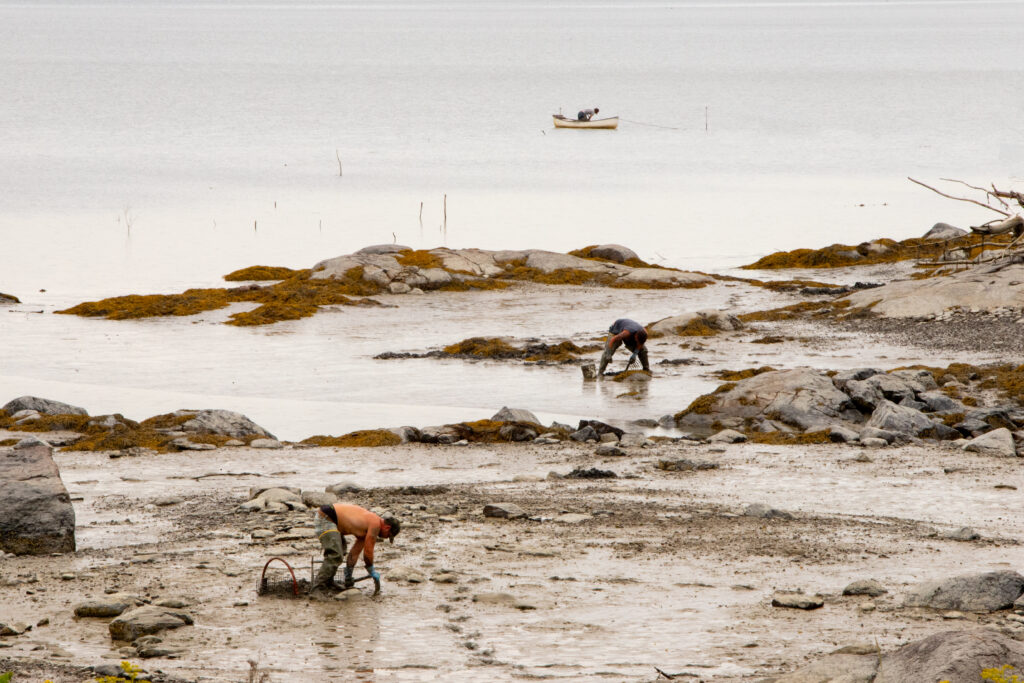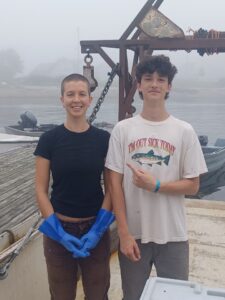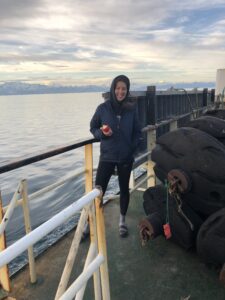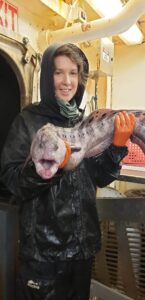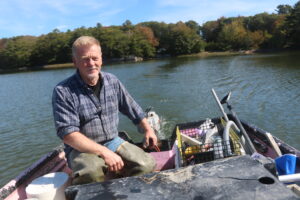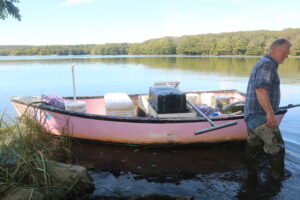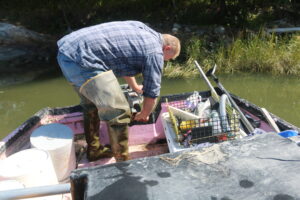“You know, it’s funny,” Terry Watson says. “When my dad got cancer, I was seventeen. He asked me what I wanted to do.” Terry says he knew he didn’t want to work at Bath Iron Works, where his dad had worked, but outside–perhaps as a park ranger on Maine’s coast somewhere, a steward of the land and water. But his mom didn’t drive, and Terry was the oldest child. He could walk out his door and start clamming in the flats that form much of this peninsula’s intertidal zone. “Fifty years later,” he laughs, “here I am.”
It’s a foggy morning in Phippsburg. We’re standing down near his pink skiff on Spirit Pond, where he’s tending an experimental oyster grow. On the other side of the road, in Atkin’s Bay, he harvests clams. Terry has sun spokes growing out of his eye corners, the deep kind of the people who spend their lives between water and sky. Every time Terry starts talking, I hear a wide river of knowledge pour out of him to fill the air between us. When he talks, he teaches, describing this Maine coast, its people, systems, and ecology. I absorb what I can.
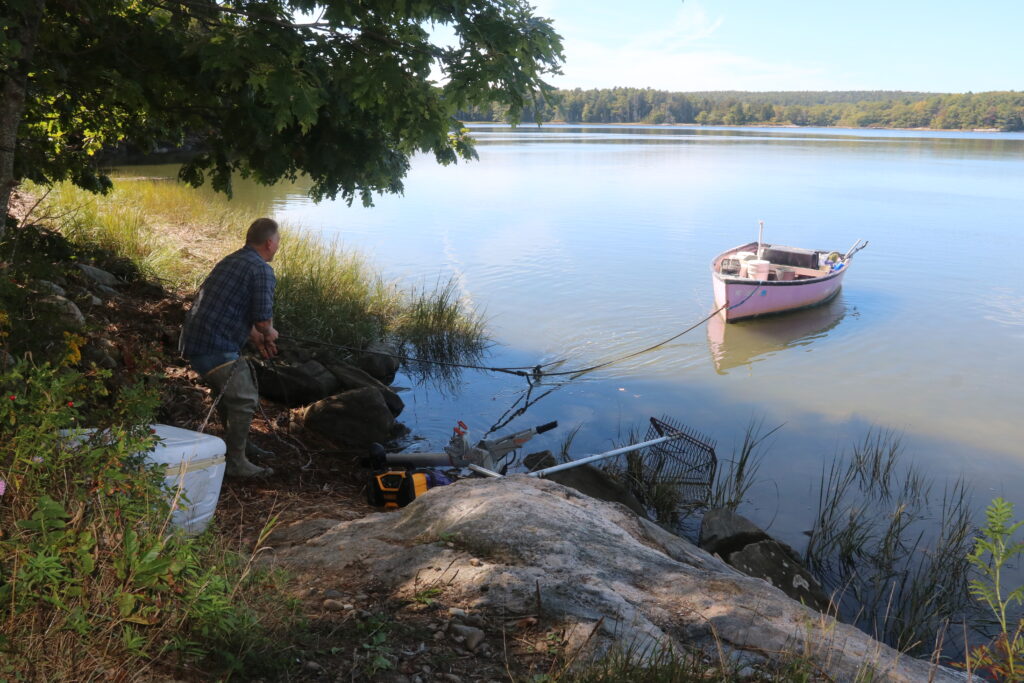
I grew up in Maine. I didn’t plan on a career spent in marine spaces, but during college I worked at the Darling Marine Center, studying the Damariscotta River. After that, I began exploring Alaskan fisheries—near-shore salmon and North Pacific groundfish. Sensing a lack of communication between the consumer and the marine harvesters, I began writing about what I saw. That led me eventually to a Fulbright Scholarship in Newfoundland and Labrador, where I studied the North Atlantic cod fishery, the rise and decline of which shaped northeastern North America.
Though all the fisheries I’ve worked in and studied are unique, they share a common pattern: unceasing fortitude in changing times.
Now I serve as Island Institute’s Phippsburg Fellow. Though all the fisheries I’ve worked in and studied are unique, they share a common pattern: unceasing fortitude in changing times. Up and down the coast of Maine, the mudflats that clammers have been accessing for decades—if not centuries—are changing. The sediment is shifting and the water is warming. And, with the coastline in socioeconomic flux, the rights to historical mudflat access points are morphing, sometimes even disappearing. Phippsburg’s Marine Resources Committee reached out to Island Institute looking for an extra set of hands. Assisting shellfish harvesters in this shifting time is a large part of why I’m here.
I’ve been working in, writing about or studying North American fisheries for the better part of the last decade, but here in Phippsburg, it’s clear that I have a lot to learn about Maine shellfish and the people that harvest them. Since day one, Terry has been invaluable in that education.
Shellfish reproduce in what is called broadcast spawning. They float about in a larval state for the first three weeks of their life, on currents large and small, until, depending on the species, they attach to hard substrate or bury themselves in mud. Major run-off events, like those big, sudden rains that turn otherwise benign watersheds into muddy torrents, can scour the larvae from the flats and inlets and fling them into the broader Atlantic.
The first day I met him, Terry talked about a piece of old newsprint a neighbor had sent him. It was the Lewiston Saturday Journal, printed on April 4, 1896. “Money in Clams,” reads the headline. The writer describes a morning scene down on Wyman’s Bay: “Nearly a hundred men are busy on the flats with their hoes and buckets.” But now, Terry says, “there’s maybe twenty guys with licenses here.” The average age ten years ago was about fifty-five. “It’s older now.”
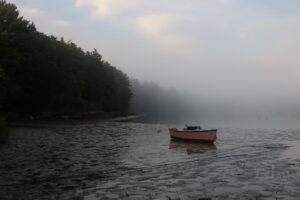
Terry Watson’s hands are thick through the knuckle, finger, and palm. They’re clam digger’s hands, saltwater hands. All around us, the tall pines are emerging; the fog is lifting away, pulling back offshore. The far side of Spirit Pond has opened, though earlier that morning it seemed you could have been standing at the edge of the ocean. On every northern coast that I’ve worked in, harvesters’ hands are the same. Thick skinned and knowledgeable.
Terry grew up here, in Phippsburg. He’s sixty-eight. Which is to say, Terry has sixty-eight years of knowledge, encompassing ecological, social, and regulatory fluctuation. He’s a storyteller. The stories are about the currents, weather, the systems and cycles we live within, so vast folks don’t always see them. Of the growing difficulty of communication–local and statewide–he says, “Everything is on a pendulum. Right center is where you want it. It doesn’t stay there long. It’ll come back.”
In a time when ecologies and economies are shifting daily, it’s clam diggers—the people out every day on these waters, in these intertidal zones—who are most intimate with the changes and patterns, large and small.
The oceanic and river currents are changing with the weather around here. In years of little rain like the last two, when the Kennebec River’s flow settles low, Terry’s shellfish larvae seed well in Atkin’s Bay. He describes a robust stock out there, in the flats. On the other hand, he’s noticed that in years of huge storms, the vulnerability of the young shellfish to predators like those voracious newcomers, the invasive green crab, increases. Innumerable details like these make up a clammer’s day.
In a time when ecologies and economies are shifting daily, it’s clam diggers—the people out every day on these waters, in these intertidal zones—who are most intimate with the changes and patterns, large and small. From anecdotal evidence comes the ideas for large scale study.
Indeed, all marine harvesters and the working waterfronts they depend on are not just about the collecting and distribution of good, local food. Harvesters are water stewards, ecological historians. Terry describes how drought years impact shellfish larvae, how the changing shape of currents along Popham Beach is shifting the distribution of shellfish growth. How warming waters change the landscape of ecological planning. To plan for a diverse, stable economy is to plan for a biodiverse, stable ecosystem.
Harvesters everywhere understand ecology in ways that traditional research cannot. While numbers and graphs are necessary for communication to the larger public, it’s the harvesters who so often see and feel change first. But like Terry said, it’s communication that’s faltering in many places. To protect marine harvesters is to protect this first, immense line of communication between humans and our ecosystem. Yesterday, he laughed. “There’s nothing wrong with talking to each other!”
There is no way to translate the entire experience of a day’s harvesting, let alone a life’s, but I’ll do what I can while I’m here. Of the currents coming out of the mouth of the Kennebec and the culture on this quiet peninsula, Terry says that things and people go around in circles. What goes in upriver doesn’t disappear. It eddies around these shores, washes up in unexpected places. “What we need,” Terry says, “is more places kids are just able to just get out in the mud with their mom or their dad and dig. Not for anything. Just dig and see what it’s like.”
I didn’t grow up here in Phippsburg, but my dad did. This is Maine! Coincidence lies thick on the ground. He and Terry were boys—living just across the street from each other, exploring the same shorelines. When I began writing about marine economies and their ecosystems and people, I lived on the other side of North America. I could not then have imagined that I had to move to my dad’s hometown to find a role so rewardingly well-suited as this fellowship.
Harvesters everywhere understand ecology in ways that traditional research cannot. While numbers and graphs are necessary for communication to the larger public, it’s the harvesters who so often see and feel change first.
In Phippsburg, I’ll be translating policy and scientific news into layman’s terms, and physical experience into narrative. More broadly, I’ll be helping to mend a communication gap between longtime—if not lifelong—Phippsburg residents and people like me, newcomers who are still learning so much about the working waterfronts of this peninsula. It’ll be folks like Terry who I will rely on to teach me what modes of communication and pieces of communal knowledge they feel are lacking.
Perhaps a fine place to start is with a reminder that the quiet, often overlooked mudflats are themselves working waterfront, whose preservation is crucial to the histories and futures of the communities that work and live upon them.
